
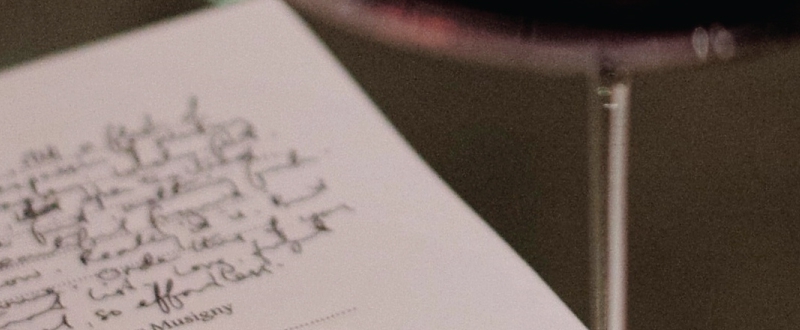
© Alexandria Rae Cubbage, 3th April 2019

The domaine, Château du Moulin-à-Vent was acquired by the Parinet family in 2009, and Edouard is the current generation leading the domaine. Linden and I visited Edouard last summer at the end of our Burgundy trip and were impressed by the terroir expression in the wines. We decided this domaine would make a nice addition to our Burghound Symposium program for 2019. Edouard joined us in Hong Kong at our new shop on 21 March to share with us the history of his domaine and to lead us in a vertical tasting of one of their single-vineyard cuvées, ‘Champ de Cour’ from the 2009 – 2017 vintage excluding the 2012. The class included two library vintages – 1995 and 1989 Château du Moulin-à-Vent both poured from magnum. All wines for the class came directly from the domaine.
Edouard began the class by way of a bit of background and explanation of the significance of Moulin-à-Vent as a cru in Beaujolais. Moulin-à-Vent is the smallest of the Beaujolais Crus and is located in the northernmost part of Beaujolais. This cru takes its name from a 15th Century windmill that’s located there. The grape variety grown here is Gamay. Edouard explained that Pinot Noir and Gamay are cousins. He noted that Gamay yields a darker colour than Pinot Noir, has lots of fruity character and has more concentration and power.

Edouard Parinet tasting the 1995 Château du Moulin-à-Vent
We also asked Edouard what makes Moulin-à-Vent distinguishable from the Cru, Morgon. He explained that the soils are different – Morgon has blue granite soil which he doesn’t believe controls the yields as much. In general, Edouard explained that the soils in Morgon are more homogeneous, not as diverse, so there are only 15-20 lieux-dits in Morgon whereas Moulin-à-Vent has approximately 65 lieux-dits.
Then, Edouard continued by describing the long history and significance of Château du Moulin-à-Vent. Beginning in 1872, the Grand Cru ‘Les Thorins’ was used in conjunction with the village name of ‘Romanèche’ just like Musigny, Chambertin and Montrachet were affixed to their respective village names of Chambolle, Gevrey and Puligny. The name of the village where the Moulin-à-Vent Cru is located is called Romanèche-Thorins.
In 1936 the AOC of Moulin-à-Vent was established. At the same time, Château des Thorins became Château du Moulin-à-Vent and was considered the reference domaine for the AOC.
Edouard explained that the vineyards of Château du Moulin-à-Vent are located in what was initially considered the grands crus part of Moulin-à-Vent, specifically the Grand Cru ‘Les Thorins’. He continued by noting that the vineyards are also special because of the influence of the wind. It can be quite powerful and this wind helps to dry and concentrate the berries. Another unique aspect of the vineyards is the manganese in the soil. There used to be a manganese mine in the village of Romanèche. The manganese and iron in the soil stresses the vines and keeps the yields lower.
Château du Moulin-à-Vent makes three different single-vineyard cuvées (and in the best years a wine called ‘Clos de Londres’ is produced from a specific clos of 0.56 hectares facing the Château), but for this class Edouard focused on just one – Le Champ du Cour. It’s located at the foot of the hill of where the famous windmill is located at 220 metres altitude so flatter terrain with deeper soils. The average age of the vines is 35-years-old.
Rose granite soil
The soils are granitic, but there is also a lot of clay. Specifically, when Linden and I visited, Edouard showed us the silica and rose granite soil in ‘Champ du Cour’. He also explained to us that clay is not an easy soil to work. It can get quite hard and very wet when it rains, so mildew is a concern. These challenges help to control the yields of this vineyard as well.
Another unique quality of this vineyard is it’s protected from the wind, so the winds are not as powerful here. Edouard explained that the wines are fresher than those located in the higher elevation vineyards of Moulin-à-Vent. Thus, the ‘Champ du Cour’ vineyard is an especially good terroir for hot vintages.
© Louisa Tsang
In terms of the winemaking, Edouard described that they make wine in the traditional way; there is no use of carbonic maceration or thermovinification. They vinify in stainless steel tanks and do around 40% of oak ageing with 15% in new oak which varies depending on the vintage. Barrels are used for up to six or seven years. For filtration, Edouard described that they do the lightest amount possible. He noted they produce about 8,000 bottles per year from the ‘Champ du Cour’ vineyard.
For this masterclass, the 2015, 2016 and 2017 were opened and tasted at 11 a.m. and then closed back with a cork until 4 p.m. Then, the cork was removed until the wine was poured for the class at 6:15 p.m. The 2009, 2010, 2011, 2013 and 2014 were opened and tasted at 4 p.m., and the cork was not placed back in the bottles. Then, the magnum of 1989 and 1995 were opened and tasted at 6:15 p.m. and poured just before they were tasted at the end of the class.
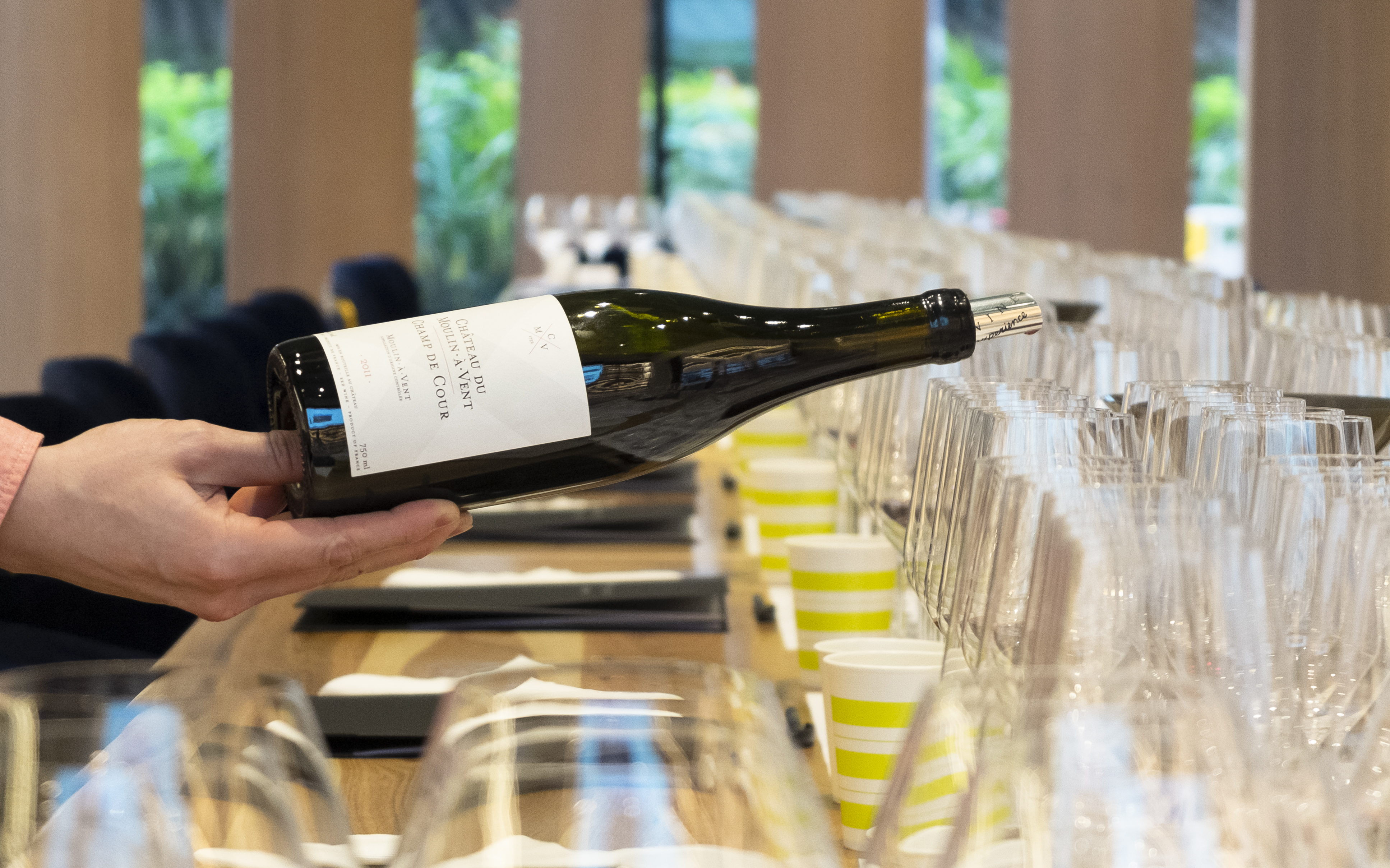
2009 Moulin-à-Vent ‘Champ de Cour’ Château du Moulin-à-Vent
The 2009 vintage experienced a heatwave in July and August combined with hot winds. Edouard explained that they harvested on 29 August with a yield of 22 hectolitres. They used 10% whole bunch in this vintage. This percentage is standard for them as they do this practice to promote a soft extraction. Edouard said they find the stem helps keep the sugar in the berries producing a longer, more fine extraction. This wine was one of the favourites of the class. It was concentrated with dark berry fruits dominating the nose. Blackberry and dark raspberry notes lead through the palate with moderate tannins and medium plus body. The tannins were refined and integrated providing structure for the fruit.
2010 Moulin-à-Vent ‘Champ de Cour’ Château du Moulin-à-Vent
The 2010 vintage had a hot July with a fresh August and September. Edouard noted that they harvested on 20th September with a yield of 23 hectolitres. Again, they used 10% whole bunch. This wine showed a combination of red and dark raspberry fruit and blackberries with floral aromas of violets intertwined. In addition, there is a minerally note in the wine and crunchy, vibrancy in the fruit. The tannins are medium but refined with a medium plus body. This vintage was one of my favourites of the night for its aroma and balance between the fruit, acidity and tannins.
2011 Moulin-à-Vent ‘Champ de Cour’ Château du Moulin-à-Vent
The 2011 vintage experienced a lot of rain at the end of the spring with a hot July and August. Edouard explained that they harvested on 29th August with a yield of 28 hectolitres. They used 10% whole bunch. I felt the impact of the rain in the wine. I found it to be a bit austere with herbal notes of thyme and sage dominating the nose. The fruit aromas were made up of dark cherries and tart raspberries. It had medium tannins that were a bit firm and lacked the refinement as well as the concentration of the other vintages.
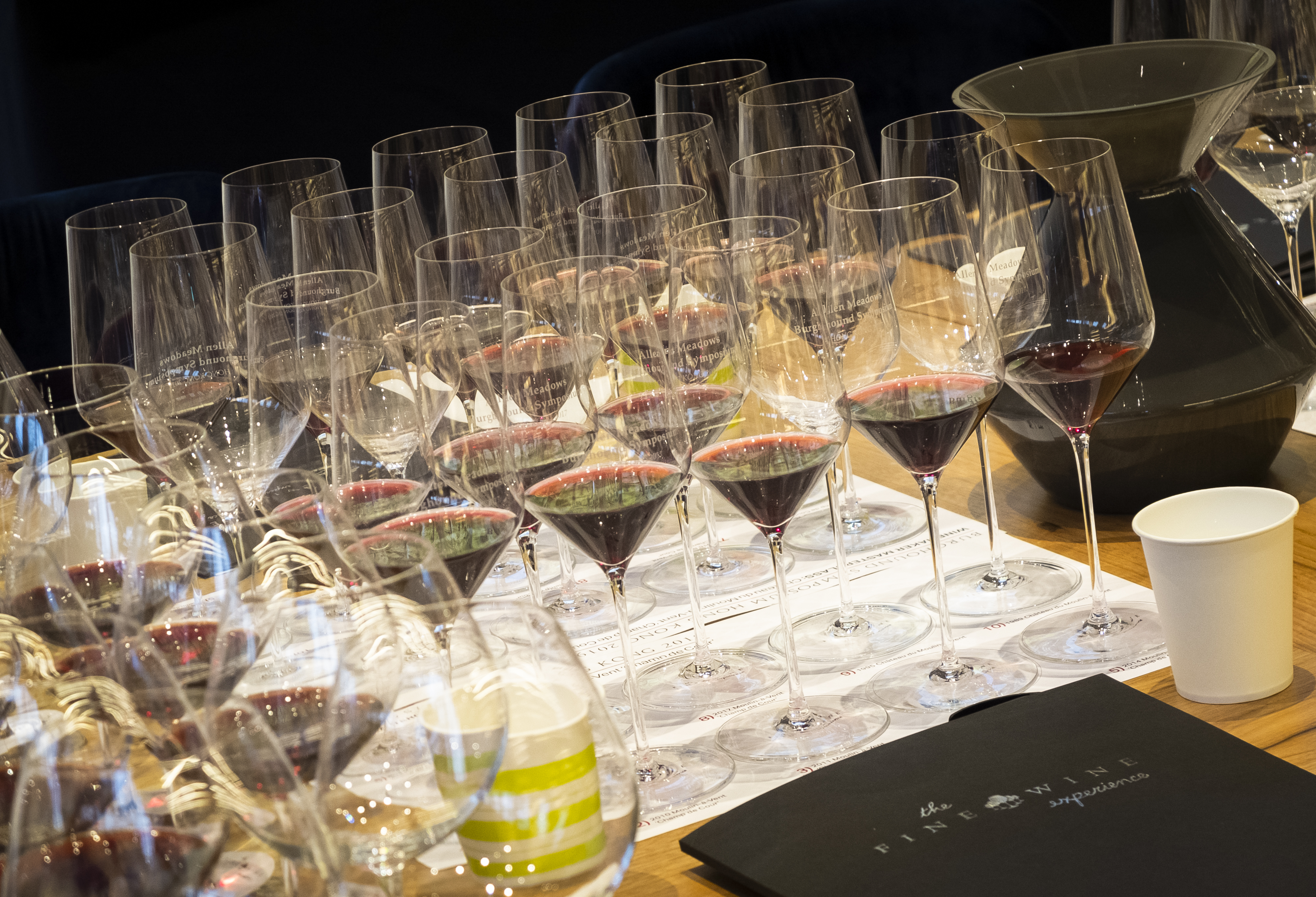
2013 Moulin-à-Vent ‘Champ de Cour’ Château du Moulin-à-Vent
Because of disease in the berries in 2012, they didn’t have enough healthy berries to produce this wine, so that’s why we didn’t have the 2012 in this vertical. Edouard described the 2013 vintage as having a fresh summer with a rainy September. Then, after the rains stopped in September, they harvested which was on 28th September. The yield was 28 hectolitres, and they used 10% whole bunch in the vinification. Edouard explained that because of the late harvest date, there is a precision to this wine with lots of acidity and finesse. The nose displayed floral aromas with flavours of raspberry and other red berries. It’s a lively wine on the nose and palate with fine-grained medium tannins and medium plus body.
2014 Moulin-à-Vent ‘Champ de Cour’ Château du Moulin-à-Vent
Edouard described the 2014 vintage as having powerful, fresh winds in the spring that delayed maturity. Then, July and August were hot, and they harvested on 9th September with a yield of 28 hectolitres. They used 10% whole bunch for the vinification. For Edouard, this 2014 reminds him of Pinot Noir because of its structure. He finds more red and dark cherry fruit as opposed to dark berry notes which he normally associates with Gamay. The wine showed red and dark cherry fruit with a hint of forest floor earthy aromas. It was well structured with medium tannins and medium plus body.
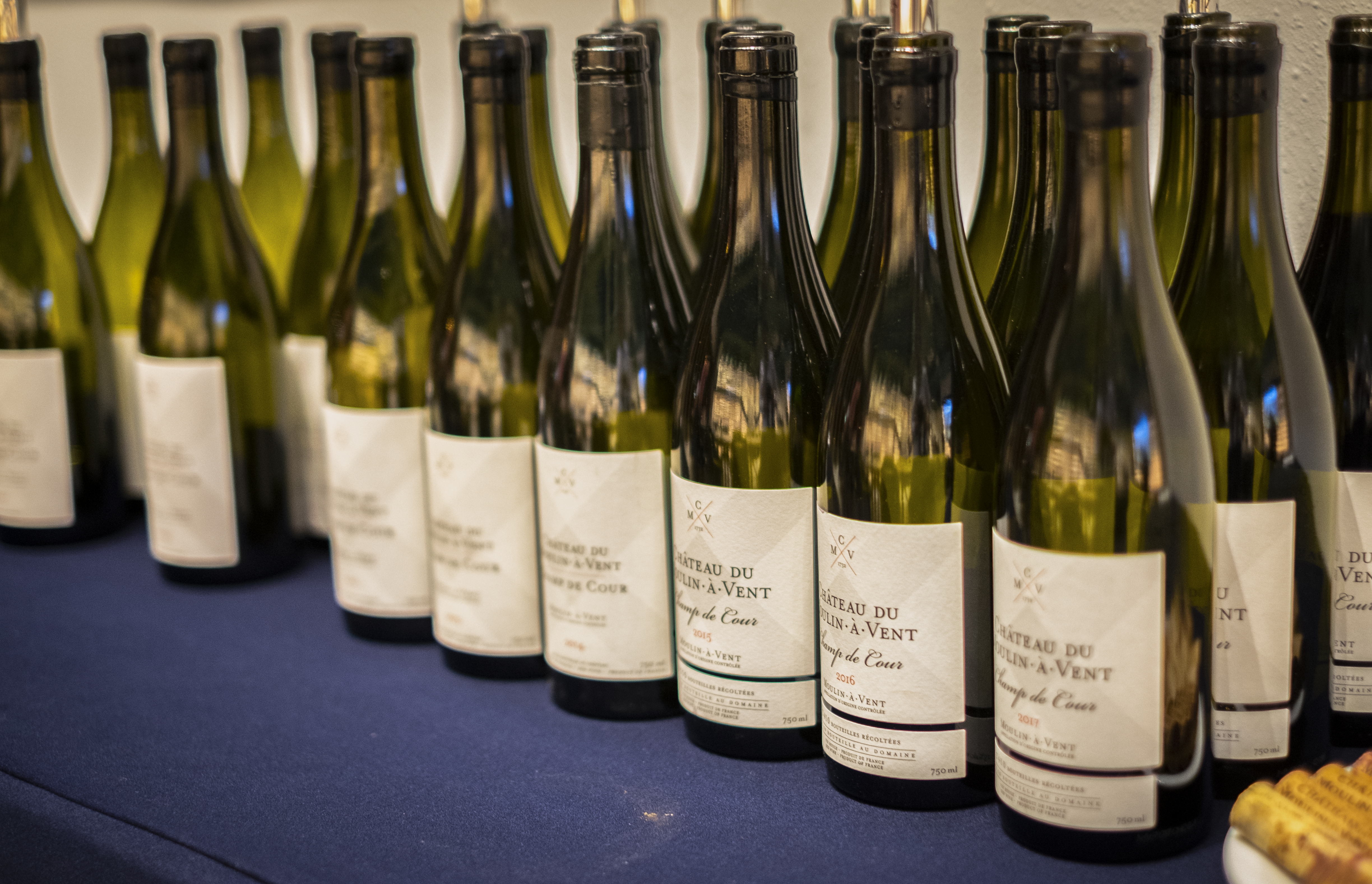
© Louisa Tsang
2015 Moulin-à-Vent ‘Champ de Cour’ Château du Moulin-à-Vent
The 2015 vintage saw a heatwave with only 170mm of rain between April and August; this amount was the lowest since 1964. Edouard also explained that there were powerful warm winds. They were the first in the appellation to harvest. Château du Moulin-à-Vent harvested on 27th August with a yield of 27 hectolitres. Because 2015 was a warm vintage, Edouard said they used 40% whole bunch in the vinification. When they have a warm vintage and healthy grapes, they like to use more whole bunch. As Allen described in his masterclass on the Role of Stems in Red Burgundy, the use of whole berry promotes intracellular fermentation, so more fruitiness in the wines. But, you need to make sure you have healthy grapes that are ripe and have some browning to the stems. The stems are a magnet for botrytis, so you have to be very careful as you select the whole bunches to use such that you don’t make the wine more prone to off flavours.
For me, the use of the whole bunch showed through in the wine as well as the warmth of the 2015 vintage both aromatically and texturally. The fruit seemed darker in character with more pronounced blackberry and dark raspberry notes with violets and other floral aromas as well as sweet spice notes. The flavours on the palate were richer in comparison to the other vintages with medium tannins and a more rounded palate that was medium plus in body. This 2015 was another favourite of the group.
2016 Moulin-à-Vent ‘Champ de Cour’ Château du Moulin-à-Vent
Edouard described the 2016 vintage as having a humid spring that lead to big leaf surface area and thus good maturity. Then, August was dry and hot, and the harvest took place on 20th September with a yield of 30 hectolitres. They used 40% whole bunch in the vinification. The wine was lively and vibrant with violets and pretty floral aromas. It’s a young wine expressively on the nose with a mix of red and dark berry, red raspberry and red cherry notes. There is also a minerally quality to the wine. The tannins are medium but refined leading through to a medium plus bodied wine with a long length. This wine was another one of my favourites of the evening as it seems like a wine with many years ahead due to its structure.
2017 Moulin-à-Vent ‘Champ de Cour’ Château du Moulin-à-Vent
The 2017 vintage saw hail and winds on the 10th July which resulted in half of the normal crop. Edouard explained that the hot and dry July and August eliminated the rotten berries. The harvest took place on 6th September, and the yield was 12 hectolitres. For the vinification, they used 10% whole bunch. The nose showed sweet fruit aromas of red and dark raspberries with sweet baking spices of cinnamon and nutmeg. The tannins were medium but rounded out by the ripe fruit. The wine was concentrated with medium plus body.
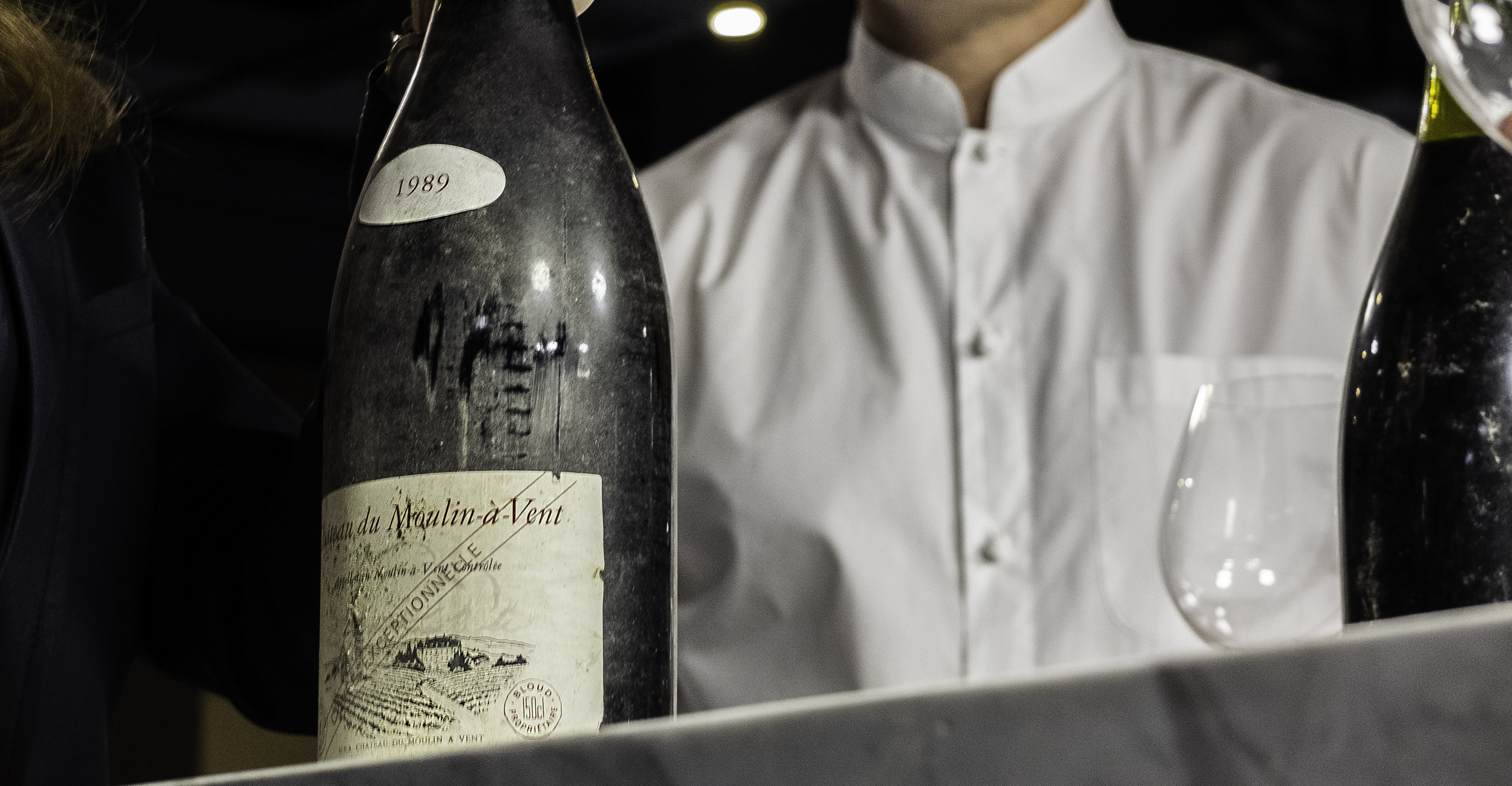
1995 Château du Moulin-à-Vent, from magnum
This 1995 was the surprise vintage Edouard sent for this class. It was poured just before tasting with no decanting. The wine showed aromas of fresh and dried dark raspberries as well as cassis and earthy mushroom and forest floor aromas with notes of underbrush. It also displayed savoury herbal aromas with a bit of charcuterie meaty flavours. One of the participants in the class commented that the Château du Moulin-à-Vent wines with age reminded her of Grenache from the Southern Rhône with similar aromas and flavours to what she finds in wines like Château Rayas. The tannins were moderate in character and integrated leading through to medium plus body and a long finish. This wine and the 1989 were made before the domaine started making the single-vineyard designated wines.
1989 Château du Moulin-à-Vent, from magnum
The 1989 showed aromas of fresh and dried red berries and red cherries with crushed autumn leaves and a touch of herbal thyme aromas. These flavours lead through to a savoury finish on the palate with a long length and refined, moderate tannins with medium plus body. There was an alluring delicacy to the wine that made it my overall favourite wine of the night. Prior to this tasting, the oldest Beaujolais Cru I had tasted was a Morgon from 1998 – Domaine J. Chamonard Morgon ‘Le Clos de Lys’.
Thank you to everyone who joined us for this enlightening vertical tasting masterclass of Château du Moulin-à-Vent ‘Champ de Cour’ tutored by Edouard Parinet. I believe we all walked away from this class with a greater appreciation of the wines of the Beaujolais Cru Moulin-à-Vent, and more specifically, the wines of Château du Moulin-à-Vent as we were able to taste through one of its single-vineyard wines from eight contrasting vintages. In addition, we were able to taste two older vintages, the 1995 and 1989. Through these examples we could see the longevity and ageability of these wines. Some saw similarities with Burgundy in the wines while others saw similarities with the Rhône and in the older wines a specific similarity to Grenache found in the Southern Rhône. For me, the wines of Château du Moulin-à-Vent fall somewhere between the wines of Burgundy and the Rhône. They are serious wines with their own unique expression worthy of your cellar. Our appreciation to Edouard Parinet for joining us in Hong Kong and sharing these wines with us. If you enjoyed these wines during the class and want more or if you missed the class and want to learn about them, our current list is linked here: http://www.finewineexperience.com/wine/?keyword=moulin+a+vent
